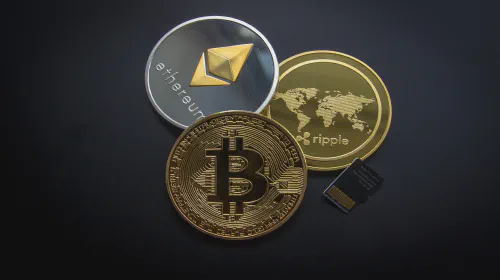What are Hyper-Deflationary Tokens? All You Need To Know
Salomon Kisters
May 10, 2023This post may contain affiliate links. If you use these links to buy something we may earn a commission. Thanks!
Hyper-deflationary tokens are a fascinating innovation in the world of cryptocurrencies. These tokens have garnered a lot of interest due to their unique tokenomics model, which involves reducing the total supply of tokens over time, thus, increasing their value.
This is achieved by burning tokens each time a transaction takes place, resulting in a reduction in the total number of tokens in circulation. As a result, hyper-deflationary tokens are becoming increasingly popular among investors and traders who are looking for new and exciting investment opportunities in the crypto space.
The world of cryptocurrency is constantly evolving, with new concepts and technologies emerging every day, but hyper-deflationary tokens are definitely one to watch. With their ability to increase in value over time, they offer an attractive investment opportunity for those willing to take a risk. However, as with any investment, it’s important to do your due diligence before getting involved with hyper-deflationary tokens or any other cryptocurrency.
In this article, we will explore some of the popular hyper-deflationary tokens currently in the market and their potential for growth.
What are Inflationary Tokens?
Inflationary tokens are a type of digital currency that has a predetermined inflation rate, meaning that the total number of tokens in circulation increases over time. Unlike Bitcoin and other cryptocurrencies that have a fixed maximum supply, inflationary tokens are designed to periodically create and add new tokens to the existing supply through mining or staking. The inflation rate is usually specified in the token’s whitepaper or the blockchain code on which it operates.
The primary objective of inflationary tokens is typically to encourage users to hold onto the tokens, as opposed to spending them, by providing a constant supply of new tokens. Moreover, the inflation rate is utilized to fund the development and maintenance of the underlying blockchain network and, in some cases, to distribute incentives to token holders or validators. Ethereum, EOS, and Polkadot are some examples of inflationary tokens.
What are Deflationary Tokens?
Deflationary tokens, on the other hand, are a form of digital currency or token that have a built-in mechanism to decrease their total supply over time. This is typically accomplished by burning a small percentage of each transaction, thus, effectively removing it from circulation. The purpose of this activity is to improve the value of the remaining tokens in circulation as demand rises due to the decrease in supply.
While deflationary tokens can be utilized in various ways, they are frequently employed as a store of value, similar to precious metals such as gold. Additionally, some investors may consider them as a safeguard against inflation since the token’s worth should, in theory, rise over time as the supply shrinks.
Nonetheless, it is important to note here that not all deflationary tokens are created equal, and some may be riskier than others. Bitcoin, Tamadoge, XRP, and Cronos are some examples of deflationary tokens.
What are Hyper-Deflationary Tokens?
Hyper-deflationary tokens have emerged as a new category in the cryptocurrency world, offering a unique model in the token economy. These tokens are designed to be deflationary in nature, making them quite different from regular tokens. As demand for such tokens continues to increase, more projects are introducing hyper-deflation mechanisms to incentivize holders. While theoretical hyper deflation is similar to regular deflation, it is difficult to measure the difference between them concretely.
One way in which hyper-deflationary tokens achieve their goal is by reducing the supply of tokens through the destruction of a certain percentage of them with each transfer. This mechanism ensures that the token supply decreases over time, leading to scarcity and potentially increasing its value. Overall, hyper-deflationary tokens offer an exciting opportunity for crypto enthusiasts looking for an alternative investment option.
Popular Hyper-Deflationary Tokens
As previously mentioned, hyper-deflationary tokens are currently a popular topic in the cryptocurrency world. These tokens have made many crypto preneurs realize their potential and how they can be successfully utilized in different projects. Some of these tokens are discussed next.
Bitcoin
As the first digital currency to be introduced to the market, Bitcoin has surely come to be synonymous with cryptocurrencies. Bitcoin is both inflationary and deflationary at the same time, with its maximum supply fixed at 21 million coins (around 19 million in circulation as of now), and once this limit is reached, no more tokens will be created. This means that miners will no longer receive block rewards, making Bitcoin an even scarcer asset to hold. Despite its constant fluctuations in value and occasional controversies, Bitcoin remains a top choice for investors and traders alike.
The foremost reason for Bitcoin to ensure deflationary tokenomics is its decentralized nature. The laws governing its supply cannot be changed, as is the case with almost every fiat currency. Once Bitcoin reaches the maximum supply mark, i.e., 21 million tokens, the blockchain will cease to create new tokens through mining rewards. The growing investor interest will help the cryptocurrency enjoy stable demand over time, which (along with the fixed supply) will allow Bitcoin to truly achieve its deflationary status.
Binance Coin (BNB)
BNB, the native coin of the Binance network, has been gaining a lot of traction lately due to its unique approach to reducing its supply. The Buyback-and-Burn mechanism used by the Binance team involves repurchasing BNB coins from investors who made over 20% profit in the last quarter and sending them to dead addresses, thereby, reducing the overall number of coins in circulation. Initially, the total supply of Binance coins was 200 million deflationary crypto coins, with a plan to burn half of them to reach 100 million coins.
On October 18th, 2021, Binance completed its 17th quarterly burn, where it burned over 1.3 million BNB coins. As of April 4th, 2023, the total supply of BNB coins is now at 159,979,964. This approach has been successful in creating scarcity and value for BNB holders, making it an attractive investment opportunity. As the demand for BNB continues to grow, it will be interesting to see how the network further manages its supply and burns more tokens in the future.
Cronos (CRO)
Cronos is a digital currency that has gained popularity by supporting the Crypto.com ecosystem. It operates by using a Proof-of-Authority consensus mechanism, which ensures fast, scalable, and cost-effective transactions. The Cronos token serves multiple use cases, including offering traders on the Crypto.com exchange discounted trading fees. Token holders can take advantage of higher APYs when utilizing Crypto.com crypto interest accounts or lower APYs when borrowing funds.
However, what sets Cronos apart from other tokens is that it is deflationary. This is because Crypto.com regularly engages in token burning to reduce the supply of CRO in circulation. This not only increases the value of the token but also creates scarcity, making it more attractive to investors. As a result, Cronos has become a go-to option for those looking to invest in a digital currency with sustainable long-term value.
According to CoinMarketCap, Cronos tokens were initially listed at a price of $0.02 when they became available on public exchanges in 2018. Since then, a large number of Cronos tokens have been destroyed, with the total number of tokens burned amounting to billions. However, the token’s value has increased significantly over time, reaching an all-time high of almost $0.97 in 2021, indicating a growth of more than 47 times.
Risks and Challenges Associated with Hyper-Deflationary Tokens
As with any investment, there are risks and challenges involved in buying and trading hyperinflationary tokens. One of the major risks is that hyper-deflationary tokens may not gain widespread adoption. If the token is not widely accepted, it may become difficult to use the token for performing transactions, which can decrease demand for the token.
Additionally, hyper-deflationary tokens are subject to volatility due to their rapid rate of supply reduction. The resulting fluctuations in token prices can be difficult to predict and may lead to significant losses for investors. Therefore, it is important for users to carefully consider their investment strategies and evaluate the potential risks associated with the tokens before investing in them.
Final thoughts
Hyper-deflationary tokens are a new type of cryptocurrency that is designed to decrease in supply over time, resulting in an increase in value. Although they are still relatively new, they have attracted significant attention in the crypto space due to their unique features.
However, investing in these tokens comes with its own risks and challenges, such as volatility and uncertainty. It is crucial to do thorough research and understand their potential downsides before investing in hyper-deflationary tokens. With careful consideration and a solid investment strategy, these digital assets can prove to be a promising addition to your portfolio.
Stay informed with the latest insights in Crypto, Blockchain, and Cyber-Security! Subscribe to our newsletter now to receive exclusive updates, expert analyses, and current developments directly to your inbox. Don't miss the opportunity to expand your knowledge and stay up-to-date.
Love what you're reading? Subscribe for top stories in Crypto, Blockchain, and Cyber-Security. Stay informed with exclusive updates.
Please note that the Content may have been generated with the Help of AI. The editorial content of OriginStamp AG does not constitute a recommendation for investment or purchase advice. In principle, an investment can also lead to a total loss. Therefore, please seek advice before making an investment decision.

DeFi Tokens vs. Coins - What is the Difference?
DeFi is everywhere. But what are DeFi tokens, and how are they different from coins?

10 Examples of Decentralized Autonomous Organizations (DAOs) - Leading Projects in the Crypto Space
Discover 10 leading examples of Decentralized Autonomous Organizations (DAOs) that are revolutionizing the crypto space. Explore the top projects and their impact on the industry.

What Is DAI Coin and Why Is It Special?
Many stablecoins are pegged to a currency like USD, usually in a 1:1 ratio. An example is the DAI coin, which we are covering in this article.
Protect your documents
Your gateway to unforgeable data. Imprint the authenticity of your information with our blockchain timestamp